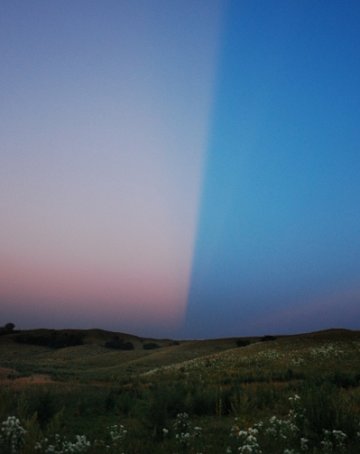
SPLIT SKY: "On my way to view the Perseid meteor shower on August 11th, I witnessed a spectacular sunset," reports Tyler Burg of Little Sioux, Iowa. "The sky seemed to split in half!"
The dark half was a vast shadow, Burg realized, and he looked around to find the source. "The shadow was cast by a thunderstorm floating between me and the sun," he says. "It was crackling beautifully with lightning."
"Later that night I witnessed 217 meteors in a 6 hour observing session," says Burg. "It was the greatest number of meteors I've ever seen in one night. In one outburst there were 41 meteors in 30 minutes, and once I saw 5 Perseids in only 30 seconds!"
more images: from Mike Holloway of Van Buren, Arkansas; from Tom Soetaert of Lawrence, Kansas; from Alan Dyer of Gleichen, Alberta, Canada; from Doug Zubenel of De Soto, Kansas
PERSEID OUTBURST: Last night, amateur astronomer Chris Peterson witnessed a flurry of bright Perseids streaking over his observatory in Guffey, Colorado. "Here are the 96 brightest recorded by my all-sky camera," he says.
Peterson plotted the frequency of events and found "a clear outburst of meteor activity around 0800 UT on Aug. 12th." That's exactly when NASA's Meteoroid Environment Office said Earth would run into a filament of dust shed by Perseid parent Comet Swift-Tuttle in 1610. Their prediction beautifully matches actual worldwide meteor counts--a demonstration that meteor science has moved into the realm of precision forecasting.
The outburst is over but the meteor shower is still underway. Stray comet dust is hitting Earth's atmosphere at 130,000 mph, producing an drizzle of 50 or more Perseids per hour. If it is dark where you live, be alert for shooting stars.



1 comment:
Haven't seen shooting stars since I left the country side. In a big city like Phoenix the sky always seems too gray to see the stars clearly although a few filter through along with the moon. Gerry
Post a Comment